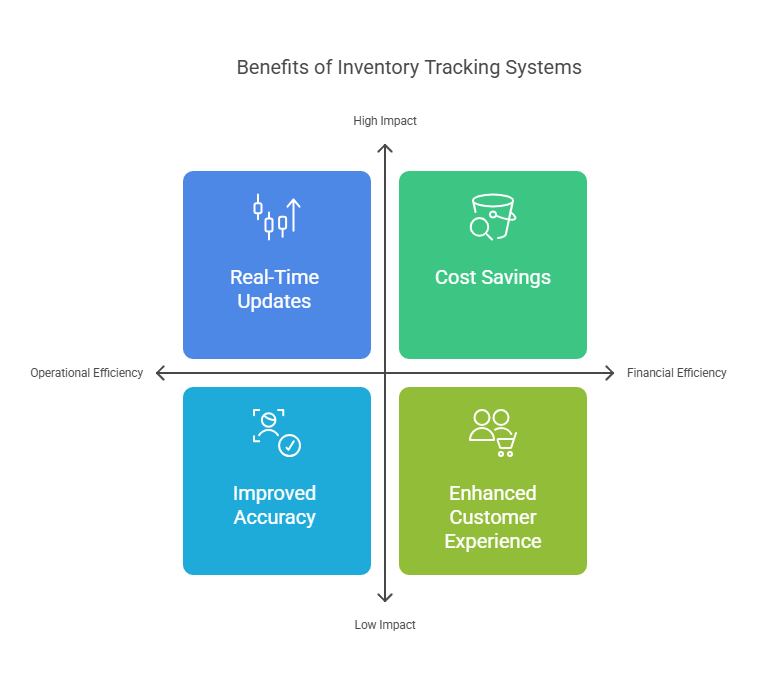How to Streamline Multi-Location Inventory Tracking & Grow Revenue

Managing inventory in multiple locations is a big challenge. Every store or warehouse has its own stock. Manual tracking can lead to errors. Products may be overstocked in one place and under-stocked in another. This imbalance can hurt revenue and customer satisfaction.
A modern inventory tracking system can solve these problems. It keeps data updated in real time. It reduces errors and makes stock management easier. In this guide, we explain how a robust inventory tracking system can help your multi-location business grow.
The Challenge of Multi-Location Inventory Management
When you run a business with several locations, the complexity increases. Each site may use its own methods. Manual processes often lead to mistakes. Data can become inconsistent. This makes it hard to know what you have at each location. Stock levels can vary greatly. These issues affect order fulfillment and customer experience.
Slow updates and miscommunication can delay reordering. This may lead to lost sales. Without a reliable system, your team may waste time on routine tasks instead of focusing on growth. These challenges underline the need for a strong, automated solution.
The Benefits of an Inventory Tracking System
- An inventory tracking system brings many benefits:
- Real-Time Updates: You can see stock levels instantly. This helps in making quick decisions.
- Improved Accuracy: Automation cuts down on manual errors. This ensures accurate inventory counts.
- Cost Savings: Avoid excess inventory and reduce storage costs. Balanced stock levels help you save money.
- Better Forecasting: Accurate data helps predict demand. This leads to smarter reordering.
- Enhanced Customer Experience: Customers find products when they need them. This builds trust and loyalty.
- These benefits not only boost your efficiency but also help grow your revenue.

Key Features of a Modern Inventory Tracking System
A good system has several essential features:
1. Cloud-Based Access
Cloud-based systems let you access data from anywhere. This is vital for multi-location businesses. You can update and view inventory in real time. This improves decision-making across all locations.
2. RFID Tracking
RFID technology uses radio waves to automatically capture inventory data. RFID doesn’t require a direct line-of-sight and can read multiple tags simultaneously, significantly speeding up data entry during check-in and check-out. It provides enhanced accuracy, real-time updates, and reduced manual labor makes them an excellent choice for complex, multi-location inventory management.
3. Real-Time Reporting
Real-time reports give you a clear view of stock levels. You can track sales, inventory changes, and trends instantly. This helps managers make quick, informed decisions.
4. Integration with POS and ERP
The system should integrate with your point-of-sale (POS) and enterprise resource planning (ERP) systems. This ensures data flows seamlessly. It minimizes manual updates and errors.
5. Automated Reordering
Automated reordering alerts you when stock is low. Some systems can even place orders automatically. This feature helps prevent stockouts and keeps the supply chain smooth.
6. Multi-Location Support
The system must handle multiple locations. It should track inventory separately for each store or warehouse. It should allow easy transfers between locations. This helps balance stock and meet customer demand.
How to Implement an Inventory Tracking System
Implementing a new system can seem daunting. Follow these steps to make the transition smooth:
Step 1: Assess Your Current Process
Start by reviewing your existing inventory management. Identify pain points such as manual errors or slow updates. Ask your team for feedback. Their insights will guide your needs.
Step 2: Define Your Requirements
List the features you need. Focus on real-time reporting, cloud-based access, and multi-location support. Decide on your budget and timeline. Clear requirements help you choose the right system.
Step 3: Research Solutions
Look for inventory tracking software that fits your needs. Read reviews and compare features. Choose a cloud-based solution that integrates with your POS or ERP systems. Make sure it has automated reordering and RFID scanning.
Step 4: Plan the Rollout
Create a clear rollout plan. Set deadlines for each phase. Train your staff on how to use the tracking system. Continuous training is key. A smooth rollout minimizes disruptions.
Step 5: Monitor and Adjust
After launch, monitor key metrics. Use real-time reports to track inventory levels and sales. Get feedback from your team. Adjust settings and processes as needed. Continuous optimization leads to long-term success.
Case Study: Success in Multi-Location Inventory Management
A retail chain with multiple stores faced constant stock imbalances. One store had too many items while another faced shortage. This eventually led to lost sales and customer dissatisfaction.
The company implemented a cloud-based inventory tracking system. With real-time data, managers could view stock levels across all locations. Automated reordering kept inventory balanced. RFID scanning reduced errors during stock updates.
Within months, the retailer saw a 25% improvement in stock accuracy. The sales cycle shortened, and customer satisfaction improved. The streamlined process led to faster order fulfillment and increased revenue. This case shows how a modern system can transform multi-location inventory management.
Tips for Successful Inventory Tracking
Here are some practical tips to maximize the benefits of your inventory tracking system:
- Train Your Team: Ensure every sales representative and warehouse staff knows how to use the system. Regular training improves efficiency.
- Keep Data Updated: Set regular intervals to update your inventory data. Real-time reporting is only useful if the data is accurate.
- Integrate Systems: Integrate your inventory tracking system with your POS and ERP systems. This minimizes manual errors and keeps data consistent.
- Use Automation: Let the system handle repetitive tasks like reordering. This saves time and reduces the chance of stockouts.
- Monitor Performance: Use the system’s reports to track key metrics. Look at inventory levels, stock movement, and reorder frequency.
- Stay Agile: Adapt your system as your business grows. Upgrade features and add new integrations to meet changing needs.
These steps help ensure that your inventory tracking is efficient and that your multi-location business can thrive.
Conclusion
A robust inventory tracking system is essential for multi-location businesses. It brings real-time data, boosts accuracy, and streamlines the sales process. With a cloud-based system, you can easily manage stock across all locations and make quick decisions. Automated features like RFID scanning and reordering help save time and reduce errors.
By implementing the right system, you can ensure that your sales team always has the products they need to close deals faster. Improved inventory management leads to a smoother sales cycle, better customer relationships, and higher revenue growth.
Take action today. Evaluate your current process, define your requirements, and choose a system that meets your needs. Train your team and monitor performance. With a modern inventory tracking system, you can streamline operations and grow your revenue.
- Art
- Causes
- Crafts
- Dance
- Drinks
- Film
- Fitness
- Food
- Juegos
- Gardening
- Health
- Home
- Literature
- Music
- Networking
- Other
- Party
- Religion
- Shopping
- Sports
- Theater
- Wellness


